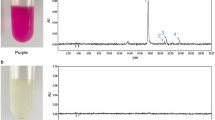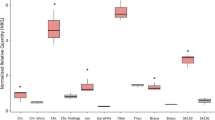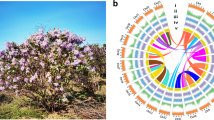Abstract
Lilium speciosum is one of the most important wild species used for breeding Oriental hybrid lily cultivars. Typical L. speciosum flowers possess red tepals and dark red anthers because of anthocyanin accumulation. However, white-flowered L. speciosum with two distinct phenotypes, one with white tepals and dark red anthers and the other with white tepals and yellow anthers, also exists. To elucidate the molecular mechanisms underlying white colouration, we isolated two regulatory genes and eight biosynthetic genes responsible for anthocyanin pigmentation in L. speciosum and compared these in red- and white-flowered lines. In the white tepal line with dark red anthers, we detected an amino acid substitution in the R2 repeat of LsMYB12, the R2R3-MYB that regulates tepal-specific anthocyanin biosynthesis, which led to reduced anthocyanin biosynthetic gene transcription and no tepal pigmentation. This LsMYB12 sequence was identical to that of an LhMYB12 in the white-flowered Oriental hybrid lily cultivar ‘Rialto’, indicating that this LsMYB12 sequence is present in lines that have been used for breeding. In addition, a nonsense mutation was detected in the dihydroflavonol 4-reductase (DFR) sequence of the white tepal line with yellow anthers, which resulted in a lack of anthocyanin accumulation in tepals and anthers. This mutated DFR has not been used for lily breeding because white tepal Oriental hybrid lily cultivars usually have dark red anthers. These results suggest that several mechanisms generate white flowers in lilies, and provide a substantial foundation for the production of Oriental hybrid lily cultivars with novel flower colour combinations.





Similar content being viewed by others
References
Abe H, Nakano M, Nakatsuka A, Nakayama M, Koshioka M, Yamagishi M (2002) Genetic analysis of floral anthocyanin pigmentation traits in Asiatic hybrid lily using molecular linkage maps. Theor Appl Genet 105:1175–1182
Asano Y (1989) Lilium L. In: Tsukamoto Y (ed) The grand dictionary of horticulture, vol 5. Syogakukan, Tokyo, pp 198–209 (in Japanese)
Baudry A, Caboche M, Lepinlec L (2006) TT8 controls its own expression in a feedback regulation involving TTG1 and homologous MYB and bHLH factors, allowing a strong and cell-specific accumulation of flavonoids in Arabidopsis thaliana. Plant J 46:768–779
Chang Y, Imam JS, Wilkinson MF (2007) The nonsense-mediated decay RNA surveillance pathway. Annu Rev Biochem 76:51–74
Comber HF (1949) A new classification of the genus Lilium. Lily yearbook, vol 13. The Royal Horticultural Society, London, pp 85–105
Du J, Rietman H, Vleeshouwers V (2014) Agroinfiltration and PVX agroinfiltration in potato and Nicotiana benthamiana. J Vis Exp 83:50971
Dubos C, Stracke R, Grotewold E, Weisshaar B, Martin C, Lepiniec L (2010) MYB transcription factors in Arabidopsis. Trends Plant Sci 15:573–581
Espley RV, Brendolise C, Chagné D, Kutty-Amma S, Green S, Volz R, Putterill J, Schouten HJ, Gardiner SE, Hellens RP, Allan AC (2009) Multiple repeats of a promoter segment causes transcription factor autoregulation in red apples. Plant Cell 21:168–183
Koes R, Verweij W, Quattrocchio F (2005) Flavonoids: a colorful model for the regulation and evolution of biochemical pathways. Trends Plant Sci 10:236–242
Lai Y, Yamagishi M, Suzuki T (2011) Elevated temperature inhibits anthocyanin biosynthesis in the tepals of an Oriental hybrid lily via the suppression of LhMYB12 transcription. Sci Hortic 132:59–65
Lai Y, Shimoyamada Y, Nakayama M, Yamagishi M (2012) Pigment accumulation and transcription of LhMYB12 and anthocyanin biosynthesis genes during flower development in the Asiatic hybrid lily (Lilium spp.). Plant Sci 193–194:136–147
Larkin M-A, Blackshields G, Brown N-P, Chenna R, McGettigan P-A, McWilliam H, Valentin F, Wallace I-M, Wilm A, Lopez R, Thompson J-D, Gibson T-J, Higgins D-G (2007) Custal W and Clustal X version 2.0. Bioinformat 23:2947–2948
Leslie AC (1982) The international lily register, 3rd edn. The Royal Horticultural Society, London
Matsui K, Umehara Y, Ohme-Takagi M (2008) AtMYBL2, a protein with a single MYB domain, acts as a negative regulator of anthocyanin biosynthesis in Arabidopsis. Plant J 55:954–967
Mol J, Grotewold E, Koes R (1998) How genes paint flowers and seeds. Trends Plant Sci 3:212–217
Morita Y, Saitoh M, Hoshino A, Nitasaka E, Iida S (2006) Isolation of cDNAs for R2R3-MYB, bHLH and WDR transcriptional regulators and identification of c and ca mutations conferring white flowers in the Japanese morning glory. Plant Cell Physiol 47:457–470
Nakano M, Nakatsuka A, Nakayama M, Koshioka M, Yamagishi M (2005) Mapping of quantitative trait loci for carotenoid pigmentation in flower tepals of Asiatic hybrid lily. Sci Hortic 104:57–64
Nakatsuka A, Izumi Y, Yamagishi M (2003) Spatial and temporal expression of chalcone synthase and dihydroflavonol 4-reductase genes in the Asiatic hybrid lily. Plant Sci 165:759–767
Nakatsuka T, Nishikawa M, Mishiba K, Yamamura S (2005) Two different mutations are involved in the formation of white-flowered gentian plants. Plant Sci 169:949–958
Nakatsuka T, Haruta KS, Pitaksutheepong C, Abe Y, Kakizaki Y, Yamamoto K, Shimada N, Yamamura S, Nishikawa M (2008) Identification and characterization of R2R3-MYB and bHLH transcription factors regulating anthocyanin biosynthesis in gentian flowers. Plant Cell Physiol 49:1818–1829
Nakatsuka A, Yamagishi M, Nakano M, Tasaki K, Kobayashi N (2009) Light-induced expression of basic helix-loop-helix genes involved in anthocyanin biosynthesis in flowers and leaves of Asiatic hybrid lily. Sci Hortic 121:84–91
Noda S (1986) Cytogenetic behavior, chromosomal differentiations, and geographic distribution in Lilium lancifolium (Liliaceae). Plant Spec Biol 1:69–78
Nørbæk R, Kondo T (1999) Anthocyanin from flowers of Lilium (Liliaceae). Phytochem 50:1181–1184
Ogata K, Hojo H, Aimoto S, Nakai T, Nakamura H, Sarai A, Ishii S, Nishimura Y (1992) Solution structure of a DNA-binding unit of Myb: a helix-turn-helix-related motif with conserved tryptophans forming a hydrophobic core. Proc Natl Acad Sci USA 89:6428–6432
Prouse MB, Campbell MM (2012) The interaction between MYB proteins and their target DNA binding sites. Biochim Biophys Acta 1819:67–77
Saitoh K, Onishi K, Mikami I, Thinder K, Sano Y (2004) Allelic diversification at the C (OsC1) locus of wild and cultivated rice: nucleotide changes associated with phenotypes. Genetics 168:997–1007
Schwinn KE, Davies KM (2004) Flavonoids. In: Davies KM (ed) Plant pigments and their manipulation, vol 14. Blackwell, Oxford, pp 92–149
Shen G, Pang Y, Wu W, Deng Z, Zhao L, Cao Y, Sun X, Tang K (2006) Cloning and characterization of a flavanone 3-hydroxylase gene from Ginkgo biloba. Biosci Rep 26:19–29
Shimizu M (1987) The lilies in Japan. Seibundo Shinkosha Publishing Co Ltd, Tokyo (in Japanese)
Smyth DR, Kongsuwan K, Wisudharomn S (1989) A survey of C-band patterns in chromosomes of Lilium (Liliaceae). Plant Syst Evol 163:53–69
Spelt C, Quattrocchio F, Mol JNM, Koes R (2000) anthocyanin1 of petunia encodes a basic helix-loop-helix protein that directly activates transcription of structural anthocyanin genes. Plant Cell 12:1619–1631
Stracke R, Werber M, Weisshaar B (2001) The R2R3-MYB gene family in Arabidopsis thaliana. Curr Opin Plant Biol 4:447–456
Takahashi R, Benitez ER, Oyoo ME, Khan NA, Komatsu S (2011) Nonsense mutation of an MYB transcription factor is associated with purple-blue flower color in soybean. J Hered 102:458–463
Toda K, Yang D, Yamanaka N, Watanabe S, Harada K, Takahashi R (2002) A single-base deletion in soybean flavonoid 3′-hydroxylase gene is associated with gray pubescence color. Plant Mol Biol 50:187–196
Yamagishi M (2011) Oriental hybrid lily Sorbonne homologue of LhMYB12 regulates anthocyanin biosyntheses in flower tepals and tepal spots. Mol Breed 28:381–389
Yamagishi M (2013) How genes paint lily flowers: regulation of colouration and pigmentation patterning. Sci Hortic 163:27–36
Yamagishi M, Kishimoto S, Nakayama M (2010a) Carotenoid composition and changes in expression of carotenoid biosynthetic genes in tepals of Asiatic hybrid lily. Plant Breed 129:100–107
Yamagishi M, Shimoyamada Y, Nakatsuka T, Masuda K (2010b) Two R2R3-MYB genes, homologs of petunia AN2, regulate anthocyanin biosyntheses in flower tepals, tepal spots and leaves of Asiatic hybrid lily. Plant Cell Physiol 51:463–474
Yamagishi M, Yoshida Y, Nakayama M (2012) The transcription factor LhMYB12 determines anthocyanin pigmentation in the tepals of Asiatic hybrid lilies (Lilium spp.) and regulates pigment quantity. Mol Breed 30:913–925
Yamagishi M, Ihara H, Arakawa K, Toda S, Suzuki K (2014) The origin of the LhMYB12 gene, which regulates anthocyanin pigmentation of tepals, in Oriental and Asiatic hybrid lilies (Lilium spp.). Sci Hortic 174:119–125
Yuan Y, Ma X, Shi Y, Tang D (2013) Isolation and expression analysis of six putative structural genes involved in anthocyanin biosynthesis in Tulipa fosteriana. Sci Hortic 153:93–102
Yuan Y, Ma X, Tang D, Shi Y (2014) Comparison of anthocyanin components, expression of anthocyanin biosynthetic structural genes, and TfF3′H1 sequences between Tulipa fosteriana ‘Albert heijn’ and its reddish sport. Sci Hortic 175:16–26
Acknowledgments
This work was supported by a Grant-In-Aid for Scientific Research (No. 24380014) from the Japan Society for the Promotion of Science.
Author information
Authors and Affiliations
Corresponding author
Additional information
The nucleotide sequences shown in this paper have been submitted to DDBJ under accession numbers AB911275–AB911317, LC066086–LC066088.
Electronic supplementary material
Below is the link to the electronic supplementary material.
Rights and permissions
About this article
Cite this article
Suzuki, K., Tasaki, K. & Yamagishi, M. Two distinct spontaneous mutations involved in white flower development in Lilium speciosum . Mol Breeding 35, 193 (2015). https://doi.org/10.1007/s11032-015-0389-z
Received:
Accepted:
Published:
DOI: https://doi.org/10.1007/s11032-015-0389-z




